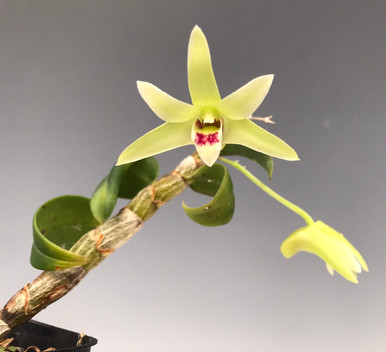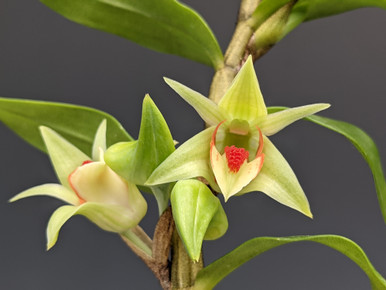Dendrobium Orchid Care
Dendrobium are popular orchids that flower from the top of the canes when mature, with each spike producing 5 to 20 flowers that last from one to three months. Some hybrids and species have the added appeal of producing fragrant flowers. When the blooms are done, cut the sprays just where they meet the canes. Many Dendrobium are deciduous and will drop their leaves before the onset of winter. This is often preceded by yellowing and spotting in the leaves. Do not remove leafless Dendrobium canes, as they will continue to bloom in the future.
Please Note: There are several types of Dendrobiums that require care more specific than this guide. Here are links to the other Dendrobium care guides:
Details on Nobile type Dendrobium can be found on the following page:
Nobile Type Dendrobium Orchid Care.
Details on specific Dendrobium sections can be found on the following pages:
Sect. Formosae – Sect. Latouria – Sect. Phalaenanthe & Spatulata.
Light and Shade
Dendrobium do well in east-facing windows, where they receive bright sunlight until noon and shade for the rest of the day. A south window is also suitable, but remember that the sun's intensity increases dramatically from March to October. A sheer curtain should be used then to filter this stronger light. In mid-summer, the sun gets so high that light may no longer reach plants sitting in a south window. During this time, it helps to place Dendrobium outside in an area of bright shade, from June through August. Be careful not to exposure these orchids to direct sunlight, as the leaves will sunburn.
Temperature and Humidity
Dendrobiums are generally warm-growing orchids (with a few species exceptions), and thrive with a day temperature range between 70°F and 85°F (20°C to 30°C). At night there should be at least a 10°F (6°C) drop, to around 60°F to 65°F (15°C to 18°C). Like many orchids, Dendrobium benefit from intermediate to high humidity levels, between 50% and 70%. This can be achieved at home with the use of a humidifier or a humidity tray. Just make sure that the plant is not standing in water or the roots will rot.
Watering
These orchids enjoy drying slightly between waterings, allowing the media to become lightly damp before watering again. While Dendrobium are capable of tolerating "bone dry" conditions, this will result in cane shriveling if turned into a habit. Most Dendrobium orchids undergo active growth from spring to early fall. During this time, they should be watered frequently and heavily. Frequent watering is particularly important during flowering, otherwise bud blasting may occur. From fall through winter, less sun results in growth pausing, and many Dendrobium enter a dry rest. For this period of time, watering can be reduced. The goal during the winter is to water the root system as necessary, without over-watering and leading to root rot. When repotting your Dendrobium during the active growing season, do not water the media for at least 3 days. This allows cuts and breaks in the roots to callous and avoid rotting upon being watered. We always recommend watering in the morning, as this gives the leaves time to dry and avoid bacterial growth overnight. If possible, use water low in alkalinity, such as rainwater, distilled water, or reverse osmosis water. If you have a dehumidifier in your home, the water that collects in the tray is excellent for watering orchids.
Feeding
We highly recommend Green Jungle Orchid Food, specially formulated to provide orchids with the nutrients they would naturally encounter in their wild habitats. This is the fertilizer that we developed to use on our own plants in production, with excellent results for decades! This formula works best with water low in alkalinity (such as rainwater, distilled water, or reverse osmosis water). However, you may use tap water, keeping in mind that mineral buildup will require repotting more frequently, on the order of every 1 to 2 years. If potting in bark mix, fertilize every time you water during the summer growing season, flushing with non-softened water once a month. This rinses the media of salt and mineral buildup. If potting in sphagnum moss, fertilize every 3rd watering during the growing season. Stop feeding in September to introduce your Dendrobium into its winter rest. This is essential for a successful flowering event in late winter or early spring.
Potting
At Orchids Limited, we recommend potting Dendrobium using New Zealand Sphagnum Moss or the Medium grade of our Traditional Orchid Bark Mix. In general, repotting should be done every 2 to 3 years in the spring. Repotting becomes necessary when the plant has outgrown its pot and the new growth reaches out over the edge, or when the potting medium has broken down. When repotting, choose a pot that is large enough to accommodate 2 or 3 years growth (2 to 3 new canes per year). Grab the plant near the base of the pot and start by gently, but firmly, pulling the plant out of its old pot. When growing in clay pots, it is sometimes easiest to simply take a hammer and break the clay pot. Do not worry about breaking or cracking roots, this will not harm the plant long term. If the mix is old, crumbly and sour, carefully remove the media and rinse the root system. Trim off any dead roots and dead canes. Position the plant with its oldest canes to the edge of the new pot. Then, spreading the plant roots out, fill in the space with the potting medium.
To divide a Dendrobium, grasp firmly but carefully at the base of the canes and wiggle the two sides back and forth until they come apart. We recommend leaving three to four canes per division. Try to untangle some of the roots for each division. To avoid the transfer of orchid diseases, it is standard procedure to sterilize all cutting and potting instruments before using them on a plant. This can be done by flaming pruning shears with a butane torch, or by spraying with rubbing alcohol and wiping with a clean paper towel.
Pest Control
The main pest that Dendrobium attract are mealybugs, which will hide in the axis where the leaf meets the cane. The best treatment for mealybug is either a homemade pesticide of 1:1 parts water & rubbing alcohol, with a few drops of dish soap added. Spray the plants every few days, washing off the dead bugs in between. For large outbreaks, an application of a specially formulated pesticide spray every few days is more effective.
Featured Products
Shop all →





